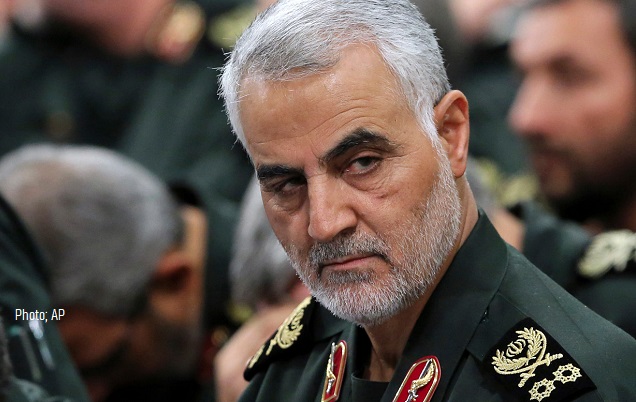VIDEO: Qassem Soleimani — Inside the twisted, terrible reign of Iran’s top general

The killing of Iranian terror-meister Qassem Soleimani in a targeted US air strike in Baghdad on Thursday will have a dramatic impact on the stability of the Iranian regime and its ability to conduct oversea terrorist operations.
Soleimani was, in many ways, the irreplaceable man. Known as a charismatic leader — indeed, the only charismatic leader in Iran’s military today — he has no parallel among contemporary Iranian commanders.
Wherever Iran has sent its expeditionary Quds Force to war — in Lebanon, Syria, Iraq, Afghanistan and Yemen — there you would find Soleimani.
During the early years of the US occupation of Iraq, he became the puppet master of successive Iraqi governments. Not only did he select presidents and prime ministers, but over the years he placed his minions in key positions in every Iraqi government ministry where they controlled personnel and finance decisions.
He also set up a far-flung financial empire, reportedly taking a percentage of the float on all foreign currency exchange from Iraqi banks, netting close to $1 billion per month in black money to finance his terror empire.
While he was serving as Barack Obama’s CIA director, Gen. David Petraeus liked to tell a story about a text message he received from Soleimani at the peak of the surge in 2008.
After the death of General Qassim Soleimani, people throughout Iran and the city of Rasht mourned him on the streets.
“Dear General Petraeus, you should know that I, Qassim Soleimani, control the policy for Iran with respect to Iraq, Lebanon, Gaza and Afghanistan. And indeed, the ambassador in Baghdad is a Quds Force member. The individual who’s going to replace him is a Quds Force member.”
Staff Sergeant Robert Bartlett was one of several thousand US soldiers wounded by “explosively made penetrators,” a particularly deadly form of IED, in Iraq. They were designed to kill American troops, and were built and shipped to Iraqi terror groups by Soleimani. In just a two-year period, from 2005-2007, they claimed the lives of an estimated 600 US servicemen in Iraq, according to the Department of Defense.
The force of the projectile “cut me in half from the left corner of my temple down to my jaw, and took my gunner’s legs off. Because of this Iranian bomb, I died three times in five days. Only my faith kept me alive,” Sgt. Bartlett told me in a videotaped interview. The US never retaliated for these attacks.
In 2011, Soleimani and his men recruited a down-and-out drug dealer named Manssor Arbabsiar, to try to assassinate then-Saudi ambassador to Washington, DC, Adel al-Jubeir, who had angered the Iranian regime by publicly calling out their terror ties.
Video shows moment Iran’s top general Qassem Soleimani is blown away.
According to federal court documents, Arbabsiar traveled repeatedly to Tehran to meet with an associate of Soleimani’s to receive orders and money and ultimately recruited a Mexican drug dealer to carry out the barbarous plot the Iranians proposed: to kill al-Jubeir while he was lunching at the upscale restaurant at the Watergate Hotel.
If successful, the bombing could have killed more than a hundred people in the heart of the US capitol, but Soleimani reportedly wasn’t worried about the collateral damage. As I wrote at the time, the only reason the plot failed was very good luck (as far as the FBI was concerned). Arbabsiar chose the wrong Mexican to carry out the hit, one who happened to be an informant for the Drug Enforcement Administration.
In recent years, Soleimani has traveled repeatedly to Syria to supervise the construction of a network of military and intelligence bases Iran planned to use to expand its presence on Israel’s borders. Israeli fighter jets reportedly narrowly missed him during a 2015 strike on an Iranian base in Aleppo province. Shortly after that attack, he told an Iranian Internet news service, “Martyrdom is what I seek in mountains and valleys but isn’t granted yet.”
Former Iranian intelligence officers told me about Soleimani’s direct involvement in planning, financing and directing the Sept. 11, 2012, attacks on US diplomatic and intelligence facilities in Benghazi, Libya, where four Americans were killed.
At the time, writing in these pages, I called him the “Wizard of Oz of Iranian terror.”
His goals in attacking us in Benghazi were to shut down the US arms pipeline from that city to the anti-regime jihadi groups in Syria and ultimately to drive the United States out of Libya entirely, both of which he accomplished.
His many brushes with death and his outrageous terror rap sheet, which is longer than bin Laden’s, led Soleimani and his supporters to consider him invincible. His demise at the hands of US forces on Thursday not only shows that is not the case but that the aura of invincibility of the regime itself is over.
I believe the Iranian people will draw the obvious conclusion that this once powerful regime has feet of clay. Expect bigger anti-regime protests inside Iran in the coming weeks and popular revolts against Iranian interference in Lebanon and Iraq as well.
To me, the biggest question remains: Is President Trump ready for the revolution he has unleashed? With this single act, the United States has set in motion big historical forces for positive change. We must be prepared to help the forces of freedom against tyranny and oppression.
RELATED ARTICLE: 5 Things to Know About Top Iranian General Killed by US Airstrike
EDITORS NOTE: This New York Post column is republished with permission. © All rights reserved.


Leave a Reply
Want to join the discussion?Feel free to contribute!